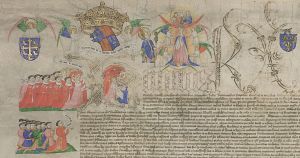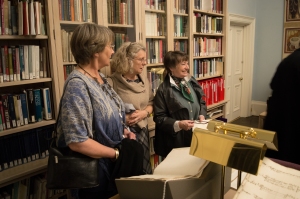The foundation of King’s College was a gradual process. Although it was founded in 1441, John Saltmarsh (1959) has pointed out that a garden belonging to Trinity Hall was bought for the intended site of King’s College on 14 September 1440 so planning must already have been well under way. A number of instruments were required to establish and endow King’s College. Principal among those are

Detail of Henry VI from the Charter upon Act of Parliament, 16 March 1445-6 (KC/18) ©DIAMM
- The Letters Patent granted by Henry VI, 12 February 1440-1 (KC/11)
- Royal Letters Patent re-founding King’s College, 10 July 1443 (KC/13)
- The Founder’s Statutes
- The Founder’s Will, 16 September 1447 – this version is known as the Windsor Will (KCW/100)
- Charter upon Act of Parliament, 16 March 1445-6 (KC/18)
At different times, items 1, 2 and 5 have been referred to as the ‘Foundation Charter’, although the true foundation charter is item number 1. Subsequent documents served to alter plans for the College, particularly enlarging it, and to endow it with further lands. Aside from the vital function these documents serve for King’s College, they are also noteworthy due to their decoration and illumination.

The Letters Patent granted by Henry VI, 12 February 1440-1 (KC/11)
The first document (above) is noteworthy as a fine example of strapwork. Here, the intricate decoration of the capital ‘H’ at the start of ‘Henricus’ includes buckles. According to an essay by Elizabeth Danbury (1989) in England and her Neighbours , strapwork first appeared in royal charters in the late 1430s and early 1440s, meaning that this and comparable royal grants to Eton upon their foundation (at the same time as King’s College) are early examples of this form of embellishment.
Embellishment of the initial letter of the King’s name is common in royal charters, though styles varied over the years. Perhaps even more striking in its decoration is the fifth item, the Charter upon Act of Parliament, 16 March 1445-6 (KC/18).

Charter upon Act of Parliament, 16 March 1445-6, in its case (KC/18) ©DIAMM
The Charter upon Act of Parliament confirmed the Founder’s earlier gifts and gave additional privileges to the College. The importance of the document is immediately obvious due to the size (approx. 99cm by 72cm), the wide margins, and the symbolism on the bottom-most of the large sheets of valuable vellum. These are joined at the lower edge and when one turns to the first sheet, which is actually at the bottom, one finds a striking illumination which depicts the purpose of the document and celebrates Henry VI’s generous gift. It also gives a visual commentary on British politics at the time.

First sheet of the Charter upon Act of Parliament, 16 March 1445-6 (KC/18) ©DIAMM
A group of miniature figures around the initial in the top left corner of this sheet represent the granting of the charter in Parliament. The figures kneeling in the left margin are the Commons and the Speaker, who bears a scroll. Above them, the Lords are depicted. They look towards the King, showing that even they are subordinate. Once again showing the importance of the initial in royal charters, the King appears kneeling at the centre of the initial ‘H’ in ‘Henricus’. Again, we see excellent strapwork. Above the Founder, angels carry his crown and the arms of England and France. Further angels carry the arms of St Edward the Confessor and St Edmund the Martyr, at the far left and right respectively. Above ‘Henricus’ are the patron saints of the College: Our Lady and St Nicholas. At the upper edge, just above Our Lady, the holy Trinity look down. Thus a hierarchical endorsement of the Henry VI’s foundation is depicted, from the House of Commons and the House of Lords below the Founder to the Lord above him.

Detail of the Charter upon Act of Parliament, 16 March 1445-6
Unusually, we know who created the wonderful illumination seen in this item. His name was William Abel. The Audit Roll of Eton College for 1447-8 (Eton College, ECR EA.3, m.9) includes a payment of 26s. 8d. for the illumination of their consolidation charter of 5 March 1446 (Danbury, 1989), which serves the same purpose as, and looks very like, the Charter upon Act of Parliament which he illuminated for King’s College.
PGM
Images of the Charter upon Act of Parliament, 16 March 1445-6 (KC/18) courtesy of DIAMM.
Danbury, Elizabeth (1989) ‘The Decoration and Illumination of Royal Charters in England, 1250-1509: An Introduction’, in Michael Jones and Malcolm Vale (eds.) England and her Neighbours: Essays in Honour of Pierre Chaplais. London and Ronceverte
Saltmarsh, John (1933) ‘The Muniments of King’s College’ in Cambridge Antiquarian Society’s Communications, vol. XXXIII
Saltmarsh, John (1959) ‘King’s College’ in Roach, J.P.C. (ed.) The Victoria history of the county of Cambridge and the Isle of Ely. , Vol.3. London
















